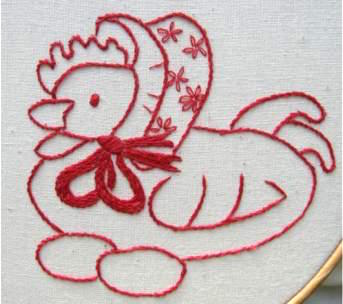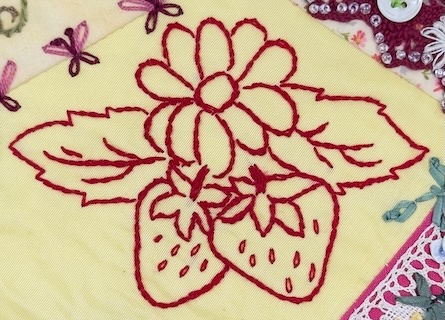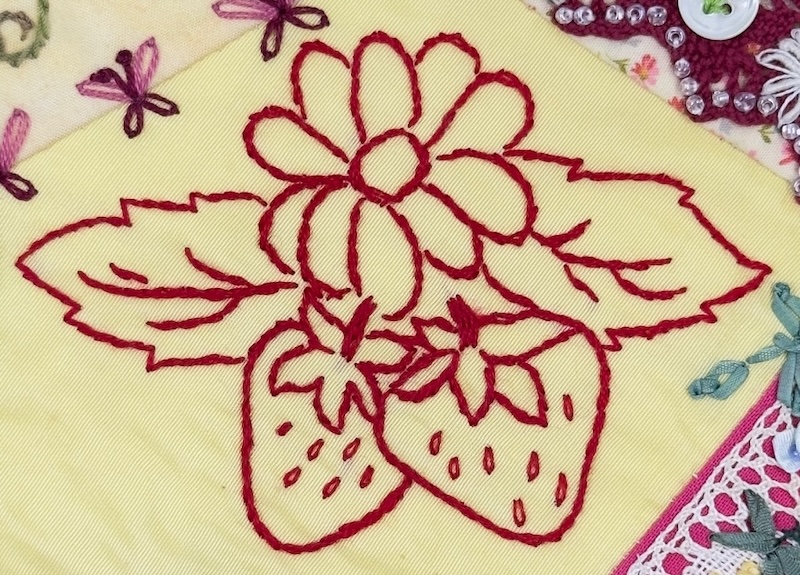- Home
- Redwork Embroidery
Think One Colour Can't Look Beautiful? Redwork Embroidery Will Change Your Mind.
If you've scrolled past embroidery tutorials thinking "I'd need months to learn all those stitches," this is for you.
Redwork embroidery uses one thread colour and four basic stitches. That's it. In a couple of hours, you'll have a finished piece you'll actually want to display - not hide in a drawer.
No experience? Perfect. This craft was designed for busy hands and simple tools.
Grab Your Free Beginner Pattern

Download the free beginner redwork pattern
This simple hen design takes under two hours to complete. You'll practise the core stitches and end up with something charming enough to frame or stitch into a cushion.
What You'll Need
- A skein of red embroidery thread
- A small hoop (6" works well)
- A scrap of muslin or calico fabric
- A needle and scissors
That's your entire kit. No specialty supplies, no expensive investment.
The Only Four Stitches You Need
Forget memorising dozens of techniques. Redwork relies on just four:
Stem Stitch - Outlines your design—the workhorse stitch
Split Stitch - Fills smaller areas with a braided look
Satin Stitch - Covers larger sections with a smooth, shiny finish
French Knots - Adds texture—perfect for eyes, berries, flower centres
Start with stem stitch. Once you're comfortable, the others will come quickly.
Quick Tip: Stem Stitch vs. Outline Stitch
These two look almost identical but twist in opposite directions:
- Outline stitch: Keep your thread above the stitching line
- Stem stitch: Keep your thread below the stitching line (if working left to right)
Left-handed? Reverse those positions.
Don't overthink it. Either one works beautifully for redwork.
Choosing Your Fabric
Two options, both affordable and easy to find:
Muslin — Lightweight and soft. Great for delicate pieces like handkerchiefs or small framed art.
Calico — Slightly thicker and sturdier. Better for items that get handled, like cushion covers or tote bags.
(Note: These are UK fabric names. Yours may differ.)
Finding Patterns
Already have the free hen pattern? Here's where to find more:
- Children's colouring books — Simple line drawings translate perfectly to redwork. Just respect copyright if you plan to sell.
- Themed pattern sets — Look for collections like "12 months of the year" or seasonal designs. Start with one; don't feel pressured to stitch the whole set.
Need help getting the design onto fabric? Check out my transfer methods guide.
Adding Details That Pop
Once you've outlined your design with stem stitch, small touches bring it to life:
- French knots for dots, eyes, or flower centres
- Lazy daisy stitches for tiny leaves or petals - this was the first stitch I learned so I've added it here in case you want to give it a try
- Satin stitch to fill small shapes like hearts or berries
Experiment. The beauty of one-colour work is that mistakes blend in—and happy accidents often look intentional.
The Story Behind Redwork
Curious where this craft came from? Here's the history.
Turkey Red Thread
In the late 1800s, embroiderers discovered a bright red thread dyed from madder root.
They called it "Turkey red," and it was a small miracle: finally, a colourfast thread that survived laundry and sunlight. Suddenly, everyday linens could carry cheerful motifs that lasted.
Today we buy colourfast thread in every colour without a second thought - but a century ago, that red spool was magic.
Let me interject here: Glenda asked how to launder redwork embroidery. Here is what I shared with her.
Let me interject here: Glenda asked how to launder redwork embroidery. Here is what I shared with her.
The Victorian Craze
After the fussy complexity of crazy quilting, redwork felt like a breath of fresh air.
The clean lines of these simple motifs, appeared on coverlets, cushions, toys, and dresser scarves - bringing quiet, handmade elegance to every room.


Penny Squares: A Traditional Trend
In the early 1900s, stitchers could buy tiny pre-printed "Penny Squares" for just a penny each. Stitch a stack, sew them together, and you'd have a lively quilt full of figures, florals, and playful scenes.
Two characters became icons: Sunbonnet Sue and Overall Sam (sometimes called Bill). Their simple silhouettes were easy to stitch and endlessly charming.
Illustrator Kate Greenaway also shaped the trend. Her drawings of children in pinafores and bonnets appeared in magazines and pattern sheets, inspiring stitchers for generations. Her gentle, nostalgic style still influences redwork today.
Lettering in Redwork
Old redwork pieces often included tiny phrases—"Good Morning," "Sweet Dreams," "With Love." Adding words made each piece feel personal, stitched for a particular person and moment.
Ready to Start?
You've got everything you need: one colour, four stitches, and a free pattern waiting.
Head over to the step-by-step page and make your first stitch →
Stay connected between projects
If you’d like occasional updates from my embroidery room, including new patterns, gentle tips, and little things I think you might enjoy, you’re warmly invited to join the Stitchin’ Times newsletter.













